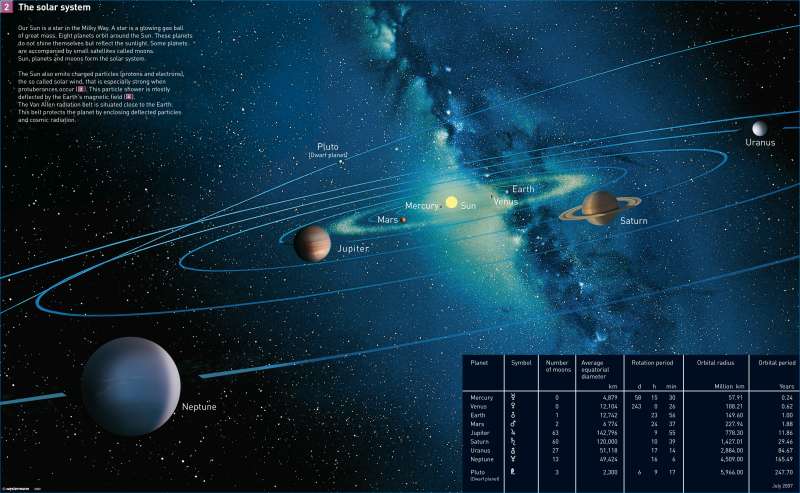The solar system
The Earth in the Universe
978-3-14-100790-9 | Page 202 | Ill. 2

Information
This illustration shows the solar system as seen "from the outside" with a band of the Milky Way in the background. The distances between the planets and their orbits are not to scale. As the Milky Way is a flat disc and the Sun is located on the same plane, it appears from Earth to be a narrow band in the night sky. The dark stripes in it are clouds of gas and dust (the latter obscures the light of the stars behind it) from which new stars can be created.Our solar system was formed by a similar cloud that collapsed in upon itself 4.6 billion years ago. A large proportion of matter collected in the centre and formed the central star — our Sun. The rest (less than two per mill) formed a disc, flattened by its rotation, from which the eight planets and their moons were created. In addition to the minor planets such as Pluto, planetoids that are predominantly located in the belt between Mars and Jupiter, and comets, the majority of which are located far beyond Pluto's orbit, were also formed.
Use this mnemonic device to remember the order of the planets: My Very Educated Mother Just Served Us Nachos.
Because it would be unpractical, distances in the universe are not measured in kilometers. Therefore within the solar system Astronomical Units (AU) are used. This is the average distance of the Earth to the Sun (about 150 Mio. km). The distance of Mars to the Sun is about 1.5 AU, of Jupiter about 5 AU and that of the most distant planet Neptune about 30 AU.
History: Discoveries in our Solar System
1610: Galileo Galilei discovers the 4 large moons of Jupiter - Io, Europa, Ganymed and Callisto
1653: Christian Huygens discovers Titan, the largest moon of Saturn
1781: Friedrich Wilhelm Herschel discovers the planet Uranus
1801: Giuseppe Piazzi discovers the dwarf planet Ceres
1846: Neptune was discovered with the help of mathematical calculations
1930: Discovery of Pluto (now a dwarf planet)
1959: Space probe Luna 3 transmits images of the rear side of the Moon
2009: Discovered moons (mostly by space probes): Mercury (0), Venus (0), Earth (1), Mars (2), Jupiter (63), Saturn (60), Uranus (27), Neptune (13).
A. Schulz, E. Astor; Ü: Joanne Moar, M. Dahl




